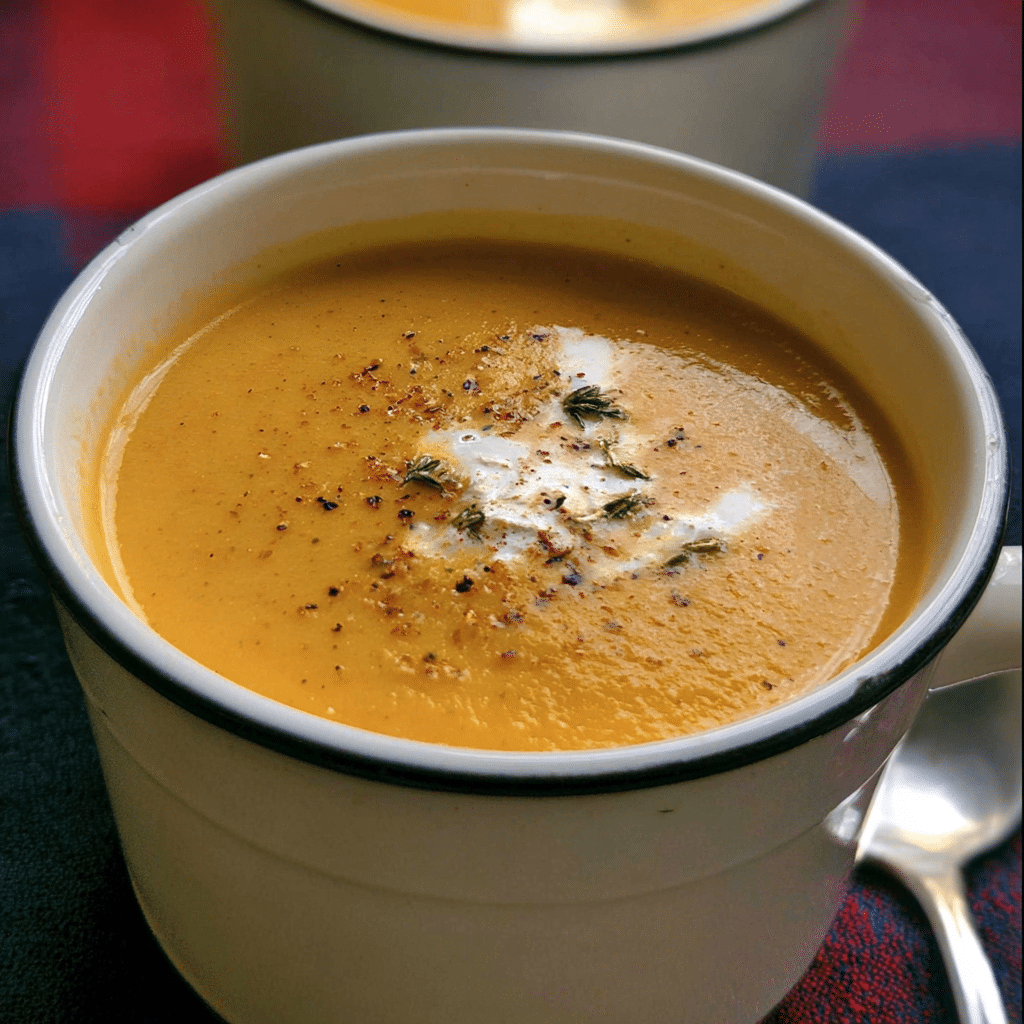Creamy butternut squash has become a beloved staple in kitchens around the world, especially as the days grow shorter and the air turns crisp. I still remember the first time I tasted a version of this delightful soup at a cozy café while visiting a quaint little town during autumn. The warm, rich flavors enveloped me like a warm hug, making me feel instantly at home. I knew right then that I wanted to recreate that experience in my own kitchen. After several attempts, I finally crafted a creamy butternut squash soup recipe that not only captured the essence of that café dish but also added my own personal touch. This soup has become a regular feature on my family’s dinner table, especially during chilly months when comfort food is a must.

The Story Behind This Recipe
There’s something magical about the first cool breeze of fall, isn’t there? It signals the time to swap out summer salads for hearty soups. My journey with creamy butternut squash soup began during one such transition. As the vibrant leaves transformed from green to shades of amber and gold, I found myself yearning for a dish that encapsulated the season. After experimenting with different ingredients and techniques, I discovered that roasting the squash before blending it into the soup created a depth of flavor that was simply irresistible. The natural sweetness of the butternut squash, combined with aromatic herbs and spices, made for a dish that was not only comforting but also incredibly satisfying.
What makes this creamy butternut squash soup special is its versatility; it can be easily adapted to suit various dietary preferences or ingredient availability. Whether you’re adding a hint of spice with cayenne pepper, swirling in a dollop of crème fraîche, or opting for a vegan version with coconut milk, there’s room for creativity. This adaptability makes it a wonderful choice for busy families looking for quick dinner solutions. You can whip it up in under an hour, and it also freezes well, making it perfect for meal prep. Just imagine coming home after a hectic day to a warm bowl of creamy butternut squash soup waiting for you in the freezer!
Seasonal relevance is another reason why this dish shines. Butternut squash is typically harvested in the fall, making it a perfect choice for autumn meals. Its vibrant color and sweet, nutty flavor reflect the essence of the season, reminding us of pumpkin patches and harvest festivals. As I ladle the soup into bowls, I often think about how food connects us to the earth and its cycles. The emotional connection I have with this dish goes beyond its flavor; it embodies the warmth of family gatherings, the joy of sharing a meal, and the comfort of home.
In this article, you will learn everything you need to know about making the perfect creamy butternut squash soup. From selecting the best squash and preparing the ingredients to the nuances of blending for that silky texture, I’ll guide you through each step of the process. You’ll also discover tips for enhancing the flavor profile, whether you prefer a simple recipe or want to elevate it with gourmet touches. So grab your apron and let’s dive into the world of creamy butternut squash!
The Rich History and Cultural Significance of creamy butternut squash
The creamy butternut squash soup has a rich history that reflects the agricultural practices and culinary traditions of various cultures. Butternut squash itself, a member of the gourd family, is native to the Americas. Archaeological evidence suggests that squash has been cultivated for thousands of years, with early varieties appearing in the diets of Native American tribes. They recognized the nutritional value of this versatile vegetable long before it became a staple in contemporary kitchen recipes. The creamy butternut squash soup as we know it today may have evolved from these early practices, as different cultures began to experiment with this ingredient.
Origins and History
The history of creamy butternut squash soup is deeply intertwined with the history of agriculture in the Americas. Early settlers and Native Americans often prepared squash in various ways, including roasting, boiling, and baking. As culinary techniques evolved, the idea of blending roasted squash into a creamy soup emerged. This method not only preserved the natural sweetness of the squash but also introduced a comforting texture that is now a hallmark of the dish.
Throughout the years, creamy butternut squash soup has been embraced by various culinary traditions. In the United States, particularly in New England, it became a popular autumn dish, often served at harvest festivals and Thanksgiving gatherings. In other parts of the world, variations of the soup have appeared, such as Thai-style butternut squash soup, which incorporates coconut milk and fragrant spices, giving it a delightful twist. This adaptability showcases the soup’s ability to transcend cultural boundaries, making it a beloved dish worldwide.
Cultural Significance
Creamy butternut squash soup is often served during festive occasions, particularly in autumn and winter months, when seasonal produce is at its peak. It is a dish that brings families together, often served as the first course at holiday dinners. The soup’s vibrant color and rich flavor evoke a sense of warmth and celebration, making it a perfect choice for gatherings. Additionally, many cultures have embraced butternut squash for its symbolism of abundance and nourishment, reinforcing its presence on the dinner table during significant occasions.
Nutritional Benefits
Beyond its delightful taste and comforting texture, creamy butternut squash soup is packed with nutritional benefits. Butternut squash is rich in vitamins A and C, providing essential nutrients for maintaining healthy skin, vision, and immune function. It is also a good source of dietary fiber, which aids digestion and promotes a feeling of fullness. This makes creamy butternut squash soup not only delicious but also a health-conscious choice for families looking to incorporate more vegetables into their meals.
In conclusion, creamy butternut squash soup embodies a rich tapestry of history, culture, and nutrition. From its origins in ancient agriculture to its evolution into a modern comfort food, this dish resonates with people from all walks of life. As you prepare to create your own version of creamy butternut squash soup, remember that you are participating in a culinary tradition that has stood the test of time, bringing warmth and joy to countless families over the years.
Essential Ingredients for Perfect creamy butternut squash
When it comes to creating a heartwarming bowl of creamy butternut squash and wild rice soup, the journey begins with the ingredients. Every spoonful of this vibrant dish is a celebration of flavors, textures, and nourishment, all of which stem from the quality and selection of the ingredients you choose. Here’s a deep dive into the essential components that make this soup not just delicious but also comforting and fulfilling.
Essential Ingredients
- Butternut Squash: 1 medium-sized, peeled and cubed (about 4 cups). This is the star of the show! Butternut squash brings a natural sweetness and creamy texture when cooked.
- Wild Rice: 1 cup, rinsed. Wild rice adds a nutty flavor and chewy texture, creating a delightful contrast against the creamy soup base.
- Onion: 1 medium, diced. Onions add depth of flavor and sweetness as they caramelize during the cooking process.
- Garlic: 3 cloves, minced. Garlic enhances the aroma and adds a savory punch to the soup.
- Carrots: 2 medium, diced. Carrots contribute additional sweetness and color, making the soup visually appealing.
- Vegetable Broth: 6 cups. This provides a flavorful base; opt for low-sodium broth to control the salt content.
- Coconut Milk: 1 can (about 13.5 oz). Coconut milk adds a rich creaminess that complements the squash beautifully.
- Olive Oil: 2 tablespoons. Used for sautéing the vegetables, olive oil also adds a healthy fat that enhances flavor.
- Salt and Pepper: to taste. Essential seasonings that bring out the natural flavors of the ingredients.
- Fresh Thyme: 2 teaspoons, or 1 teaspoon dried thyme. Thyme adds an earthy aroma that pairs wonderfully with the sweetness of the squash.
- Lemon Juice: 1 tablespoon. A splash of acidity brightens the flavors, making the soup more vibrant.
Each ingredient in this creamy butternut squash soup plays a crucial role. The butternut squash is the primary ingredient, with its sweet, nutty flavor providing the foundation of the dish. It’s essential to select a squash that feels heavy for its size, with a smooth, firm skin and no soft spots. When you cut into it, the flesh should be a deep orange color, indicating ripeness and flavor.
The wild rice, known for its chewy texture and nutty aroma, adds heartiness to the soup. When purchasing wild rice, look for a mix of colors, as this usually indicates a higher quality. Rinse it thoroughly before cooking to remove any excess starch, which can make the soup cloudy.
Print
Creamy Butternut Squash Recipe
Ingredients
- 3 pounds butternut squash – cubed
- 3 tablespoons olive oil
- 2 cups vegetable or chicken stock – more as needed
- 1 large carrot – peeled and chopped
- 1 green apple – peeled and chopped
- 1 red bell pepper – seeded and chopped
- 1 white or yellow onion – diced
- 1 stalk celery – chopped
- 1 tablespoon minced garlic
- 1 teaspoon salt – or to taste
- ¼ teaspoon pepper – or to taste
- ½ teaspoon smoked paprika – optional
- 2 15-ounce cans unsweetened coconut milk
- optional garnishes: dried cranberries, sunflower seeds, parsley or thyme, pepitas or roasted pumpkin seeds, black pepper, parmesan cheese, smoked paprika
Instructions
- In a large stockpot over medium-high heat, combine olive oil, butternut squash, carrot, apple, bell pepper, garlic, onion, and celery. Saute 3-4 minutes until garlic fragrant and onions are translucent.
-
Add stock, salt and pepper, and smoked paprika (if using) and bring to a boil. Cook for 5-10 minutes over medium heat until veggies and squash are very tender.
-
Stir in the coconut milk. Use an immersion blender to blend until smooth OR transfer in batches to a high powered blender and puree until smooth and creamy.
-
Taste, add salt and pepper to taste if needed. Add a little more stock or water to thin if needed. Garnish as desired and serve.
Shopping Tips
When shopping for your ingredients, consider seasonal availability. Butternut squash is typically in season from late summer through early winter, making it the perfect time to enjoy its sweet flavor. Local farmers’ markets often have the best selection and quality, so take the opportunity to support them when possible.
For the vegetable broth, you can either buy store-bought or make your own. Homemade broth allows for customization of flavors and ensures no unnecessary additives. When choosing coconut milk, look for full-fat varieties for the creamiest texture; shake the can before opening to ensure the cream is evenly distributed.
When it comes to herbs like thyme, fresh is always preferable, as it offers a brighter flavor. However, if you only have dried thyme on hand, it can be used as a substitute—just remember that dried herbs are more concentrated, so you’ll need less. Always check the expiration date of dried herbs to ensure their potency.
Substitutions and Alternatives
Dietary restrictions can easily be accommodated with a few simple substitutions. For a vegan version of creamy butternut squash soup, ensure that the vegetable broth is free from animal products, and stick with coconut milk or cashew cream for the creamy base. If you’re looking for a lower-calorie option, you can substitute half of the coconut milk with unsweetened almond milk, though the texture and richness will be slightly different.
For those who are gluten-free, wild rice is a natural choice, but if you’re looking for a different grain, quinoa or brown rice can work too. Just be mindful of the cooking times, as they may vary. If you have nut allergies, using sunflower seed butter can mimic the creaminess without the risk.
Storage is also an important consideration. Fresh butternut squash can be stored in a cool, dry place for several weeks, while wild rice has a longer shelf life when kept in an airtight container. Leftover soup can be stored in the refrigerator for up to 5 days or frozen for up to 3 months. Just be sure to allow it to cool completely before transferring it to a freezer-safe container.
In terms of budget, purchasing ingredients in bulk can save money, especially for items like wild rice and vegetable broth. Keep an eye out for sales at your local grocery store or consider buying from bulk bins if available. This can also allow you to experiment with different types of rice or grains in your soup for added variety.
In conclusion, the foundation of a great creamy butternut squash and wild rice soup lies in selecting high-quality ingredients. Each component contributes to the overall flavor and texture, creating a dish that is not only satisfying but also a joy to prepare. From picking the right squash to finding the best broth, these details will elevate your cooking experience and result in a deliciously creamy butternut squash soup.
Detailed Step-by-Step creamy butternut squash Cooking Instructions
Now that we have gathered all the essential ingredients for our creamy butternut squash and wild rice soup, it’s time to dive into the cooking process. This section will guide you through each step with detail and care, ensuring that your soup turns out perfectly every time. So, roll up your sleeves and let’s get started!
Preparation Steps
- Gather Your Ingredients: Before anything else, ensure you have all your ingredients laid out. This is known as mise en place, which translates to “everything in its place.” This not only streamlines your cooking but also allows you to focus on the process without scrambling for ingredients mid-recipe.
- Prep the Vegetables: Start by peeling and cubing the butternut squash. A good tip is to cut off the ends of the squash first for stability. Use a sharp chef’s knife to carefully peel the skin, and then cut it into manageable cubes. Aim for uniform sizes to ensure even cooking.
- Dice the Onion and Carrots: Next, take your onion and carrots. For the onion, cut it in half, peel off the skin, and dice it into small pieces. For the carrots, make sure to wash them thoroughly, peel them, and chop them into small cubes to match the size of your other vegetables.
- Minced Garlic: Finally, take your garlic cloves and mince them finely. The more finely you chop, the more intense the garlic flavor will be.
Cooking Process
- Heat the Olive Oil: In a large pot or Dutch oven, heat the olive oil over medium heat. You’ll know it’s ready when it shimmers slightly but isn’t smoking.
- Sauté the Vegetables: Add the diced onions first and sauté them for about 3-4 minutes until they become translucent. Then add the minced garlic and diced carrots, cooking for another 2-3 minutes. Stir occasionally to prevent sticking and ensure even cooking.
- Add the Butternut Squash: Once the onions and carrots are softened, add the cubed butternut squash to the pot. Stir everything together to coat the squash in the olive oil and to incorporate the flavors from the sautéed vegetables.
- Incorporate the Wild Rice: Now, add the rinsed wild rice. Stir it in with the vegetables, allowing it to absorb some of the flavors from the pot for about 1-2 minutes.
- Pour in the Broth: Carefully pour in the vegetable broth, ensuring that all the ingredients are submerged. Bring the mixture to a boil, then reduce the heat to a simmer. This is a great time to add in your thyme and a pinch of salt and pepper.
- Simmer: Cover the pot and let the soup simmer for about 25 minutes, or until the wild rice is tender. Stir occasionally to prevent sticking and to monitor the cooking process. The wild rice will begin to split open, releasing its nutty flavor.
- Add the Coconut Milk: Once the rice is cooked, stir in the coconut milk. This is where the soup transforms into a creamy butternut squash delight. The coconut milk will give the soup a velvety texture and enhance its flavor profile.
- Blend for Creaminess (Optional): If you prefer a smoother texture, use an immersion blender to puree some of the soup directly in the pot. This step is optional; you can leave it chunky if you enjoy the texture of the vegetables and rice. If using a traditional blender, allow the soup to cool slightly before pouring it into the blender to avoid splattering.
Final Assembly
- Season to Taste: After blending (or not), taste the soup and adjust the seasoning as needed. Add more salt, pepper, or a squeeze of lemon juice to brighten up the flavors.
- Serve Hot: Ladle the creamy butternut squash and wild rice soup into bowls. For an added touch, garnish with fresh thyme leaves, a drizzle of olive oil, or even a sprinkle of pumpkin seeds for crunch.
- Enjoy: Sip and savor every spoonful of your homemade soup. The combination of sweet butternut squash, hearty wild rice, and rich coconut milk is sure to warm your heart and fill your belly.
Cooking creamy butternut squash and wild rice soup is not just about following a recipe; it’s about enjoying the process and creating something meaningful. The beautiful colors and rich aromas that fill your kitchen are part of the experience. With these detailed cooking instructions, you can confidently create a delicious and satisfying soup that embodies comfort and warmth, perfect for any occasion. Remember, cooking is an art, and with practice, you’ll find your rhythm and style!

Professional Tips and Techniques for creamy butternut squash
When it comes to making a delicious bowl of creamy butternut squash soup, the difference between an ordinary soup and an extraordinary one often lies in the details. As someone who has spent countless hours perfecting this recipe in my kitchen, I’m excited to share some professional tips and techniques that will elevate your soup game. From choosing the right ingredients to mastering cooking techniques, let’s dive into the world of creamy butternut squash soup.
Professional Techniques
One of the first things to consider when preparing creamy butternut squash soup is the selection of your squash. Look for a firm, heavy butternut squash with a smooth, tan skin. A fresh squash will yield a sweeter flavor and a creamier texture, essential for a comforting soup. Before cutting into your squash, be sure to wash the exterior thoroughly to remove any dirt. Using a sharp chef’s knife, carefully slice the squash in half lengthwise and scoop out the seeds. Roasting the squash is a technique I highly recommend. It caramelizes the natural sugars, enhancing the flavor profile of your soup.
Preheat your oven to 400°F (200°C) and place the squash halves cut-side down on a baking sheet lined with parchment paper. Roast for about 40-50 minutes, or until the flesh is tender. This method not only brings out the sweetness of the squash but also adds a depth of flavor that boiling simply can’t achieve. If you’re short on time, you can steam the squash, but I promise that roasting is worth the extra effort.
To create a creamy texture without heavy cream, consider using coconut milk or cashew cream. This is a great way to keep your soup dairy-free while still achieving that luxurious mouthfeel. If you prefer a traditional approach, whole milk or heavy cream can be added for richness, but I often find that a touch of nutmeg or cinnamon can enhance the flavors without overwhelming them.
Troubleshooting Guide
Even the most seasoned cooks encounter hiccups while preparing creamy butternut squash soup. A common issue is the soup being too thick. If you find yourself in this situation, simply add more stock or water to achieve your desired consistency. On the flip side, if your soup is too thin, you can simmer it a bit longer to reduce it, or add a slurry of cornstarch and water to thicken it up.
Another challenge may arise when it comes to seasoning. Start with salt and pepper, but feel free to explore other herbs and spices. If your soup tastes bland, try adding a splash of apple cider vinegar or lemon juice to brighten the flavors. Remember, tasting as you go is key to creating a balanced dish.
Presentation Tips
Presentation can make all the difference when serving your creamy butternut squash soup. Consider serving it in rustic bowls or even hollowed-out mini pumpkins for a festive touch during the fall season. To elevate your presentation further, drizzle a swirl of coconut cream or heavy cream on top just before serving. A sprinkle of toasted pumpkin seeds, fresh herbs like parsley or chives, or a dash of paprika can add color and texture, turning a simple bowl of soup into a stunning centerpiece.
For beverage pairings, a glass of crisp white wine, such as Sauvignon Blanc or a buttery Chardonnay, complements the flavors beautifully. If you prefer a non-alcoholic option, consider serving your soup with a refreshing apple cider or a classic ginger ale, both of which will harmonize well with the sweet notes of the butternut squash.
Meal prep is another way to save time. You can roast the squash ahead of time and store it in the refrigerator for up to three days. The soup also freezes well; just remember to leave some space in the container as it will expand when frozen. To make the process even smoother, consider doubling the recipe and having some on hand for those busy weeknights when you crave something comforting yet nutritious.
Overall, creating a bowl of creamy butternut squash soup can be a delightful experience filled with warmth and flavor. With these professional tips and techniques, you’ll be well on your way to mastering this comforting dish that will surely impress your family and friends.
Creative Variations and Adaptations of creamy butternut squash
While the classic creamy butternut squash soup is a beloved staple, the beauty of cooking lies in its flexibility. There are countless variations and adaptations that can make this dish uniquely yours. Let’s explore some creative ways to switch things up, ensuring you never get bored of this comforting favorite.
Seasonal Variations
One of the best aspects of creamy butternut squash soup is its adaptability to seasonal ingredients. In the fall, consider adding roasted apples or pears for a hint of sweetness that complements the squash beautifully. In the winter months, a touch of sage or rosemary can provide an earthy depth, while in the spring, incorporating fresh herbs like basil or cilantro can brighten the dish significantly.
In the summer, you might want to blend in some fresh corn or zucchini to lighten the soup and add a fresh twist. The key is to let the seasons guide your ingredients, allowing you to create a dish that feels relevant and fresh no matter the time of year.
Dietary Adaptations
For those following specific dietary restrictions, the creamy butternut squash soup can be easily modified. If you’re looking for a vegan option, simply swap out any dairy for coconut milk or almond milk. For a gluten-free version, ensure your vegetable broth is gluten-free, as some brands may contain gluten additives. If you’re following a keto diet, you can reduce the carbs by using less squash and incorporating low-carb vegetables like cauliflower to maintain the creamy texture.
If you’re a spice lover, don’t hesitate to adjust the spice level. You can add a pinch of cayenne pepper for some heat or even a dash of curry powder for an exotic twist. The beauty of this soup is in its versatility, allowing you to tailor it to your taste preferences.
Creative Twists
If you feel adventurous, consider fusing different culinary traditions into your creamy butternut squash soup. For instance, adding a touch of miso paste can introduce umami flavors reminiscent of Japanese cuisine. Alternatively, incorporating Thai red curry paste can transform your soup into a vibrant and fragrant dish that speaks to Southeast Asian flavors.
Another fun twist is to explore different cooking methods. While the traditional route of roasting and pureeing is delightful, you can also opt for a slow cooker method. Simply toss your chopped butternut squash, broth, and spices into the slow cooker, set it on low for 6-8 hours, and let it work its magic. The result is a hands-off approach that yields a rich and flavorful soup without much fuss.
And if you find yourself with leftovers, don’t let them go to waste! Transform your creamy soup into a delicious pasta sauce by adding it to cooked pasta and tossing in some sautéed vegetables. You can even use it as a base for a risotto, combining it with arborio rice and gradually adding broth for a creamy, dreamy dish.
With these creative variations and adaptations, the world of creamy butternut squash soup is endless. Each bowl can be a new adventure, allowing you to explore flavors and techniques while enjoying this comforting dish. So, gather your ingredients and let your culinary imagination run wild!
Storage, Reheating, and Meal Prep for creamy butternut squash
When it comes to enjoying the deliciousness of creamy butternut squash and wild rice soup, knowing how to properly store, reheat, and prepare this comforting dish can significantly enhance your culinary experience. After all, who doesn’t love a warm bowl of soup on a chilly day? In this section, I will guide you through the ins and outs of storage, reheating, and meal prep strategies that ensure each bite of your creamy butternut squash soup remains just as delightful as the first.
Short-term Storage
Once you’ve whipped up a batch of creamy butternut squash soup, you might wonder how to store it for later enjoyment. If you plan to eat the soup within a few days, the refrigerator is your best friend. Start by letting the soup cool to room temperature. This is a crucial step, as placing hot soup directly into the fridge can raise the overall temperature of your refrigerator, potentially harming other stored foods.
For short-term storage, opt for airtight containers made from glass or BPA-free plastic. Glass containers work wonders as they don’t retain odors and are microwave-safe. Ensure the soup is placed in the container with enough headspace at the top; this allows for any expansion that might occur during refrigeration. Label the container with the date you made the soup to keep track of its freshness. Properly stored, your creamy butternut squash soup should last in the refrigerator for about 3 to 5 days.
Freezing and Long-term Storage
If you find yourself with a larger batch of creamy butternut squash soup or simply want to prepare in advance for busy nights, freezing is an excellent option. However, it’s essential to note that freezing can change the texture of some ingredients, particularly dairy. If your recipe includes cream or milk, consider adding those ingredients when reheating instead of before freezing. This ensures a creamy texture upon thawing.
To freeze your soup, use freezer-safe containers or heavy-duty freezer bags. If you’re using bags, lay them flat in the freezer for efficient storage. When filling containers or bags, leave about an inch of space at the top to allow for expansion. Don’t forget to label these containers with the date and contents to make future meal prep a breeze! Your creamy butternut squash soup can be safely stored in the freezer for up to 3 months.
Reheating Best Practices
When the time comes to enjoy your creamy butternut squash soup again, reheating it properly is key to retaining its delightful flavors and textures. If frozen, allow the soup to thaw overnight in the refrigerator. For quicker thawing, you can use the microwave on a low setting, stirring occasionally to ensure even heating.
When ready to reheat, transfer the soup to a pot over medium heat. Stir frequently to prevent it from sticking to the bottom of the pot. If you find that the soup has thickened during storage, feel free to add a splash of vegetable broth or water to reach your desired consistency. If you had left out dairy before freezing, now is the time to stir in cream or milk, allowing the soup to come to a gentle simmer. This method helps maintain the creamy texture and rich flavor of your butternut squash soup.
It’s also important to keep food safety in mind. Always reheat your soup to a minimum internal temperature of 165°F (74°C) to ensure any potential bacteria are eliminated. If you have leftover soup that has been reheated, do not refreeze it. Instead, enjoy it within a few days.
Lastly, let’s talk about meal prep and batch cooking. Creamy butternut squash soup is a fantastic candidate for batch cooking, especially in the fall when squash is abundant. Making a large pot means you can portion it out into individual servings, which can be a lifesaver for busy weeknights. Consider portioning your soup into single-serving containers, making it easy to grab and go. This way, you can always have a healthy meal option on hand, without the need to cook from scratch every time.
In summary, proper storage and reheating of creamy butternut squash soup can elevate your meal prep game. By following these guidelines, you can ensure that your soup remains delicious, safe, and enjoyable for days to come.
Nutritional Benefits and Health Information
When you’re savoring a bowl of creamy butternut squash and wild rice soup, it’s not just the comforting flavors that stand out; the nutritional benefits of this delightful dish are equally impressive. Packed with vitamins, minerals, and wholesome ingredients, this soup can be a fantastic addition to any diet. In this section, we will delve into the nutritional profile of creamy butternut squash soup, highlighting its health benefits, dietary considerations, and potential modifications.
Nutritional Profile
At the core of creamy butternut squash soup is, of course, the butternut squash itself. This vibrant orange vegetable is not only visually appealing but also a powerhouse of nutrition. A one-cup serving of cooked butternut squash contains approximately 82 calories, 0.2 grams of fat, 22 grams of carbohydrates, and 2 grams of protein. It’s also an excellent source of dietary fiber, boasting about 6.6 grams per serving, which helps promote digestive health.
In terms of vitamins, butternut squash is particularly rich in vitamin A—thanks to its high beta-carotene content—which supports eye health, immune function, and skin health. Additionally, it provides significant amounts of vitamin C, which is essential for the growth and repair of tissues in the body. When combined with wild rice, which adds protein and a unique nutty flavor, the overall nutritional profile of the soup becomes even more robust.
Wild rice is a whole grain that is higher in protein compared to other grains, with about 6.5 grams per cooked cup. It also contributes essential minerals like zinc, phosphorus, and magnesium, making the soup not only hearty but also nutrient-dense.
Health Benefits
The health benefits of creamy butternut squash soup extend beyond its individual ingredients. The combination of butternut squash and wild rice creates a balanced dish that can be a part of a healthy diet. The high fiber content aids in digestion and can help maintain healthy cholesterol levels. Furthermore, the antioxidants found in butternut squash, particularly carotenoids, may have anti-inflammatory properties and are linked to a reduced risk of chronic diseases.
Moreover, the soup can be a comforting choice during colder months, helping to boost your mood and immune system. As a warm and hearty meal, it can provide a sense of satisfaction without weighing you down, making it an ideal option for those looking to maintain or lose weight.
Dietary Considerations
When it comes to dietary considerations, creamy butternut squash soup can be quite versatile. For those following a vegan or dairy-free lifestyle, simply substitute coconut milk or almond milk for any cream in the recipe. This not only maintains the creamy texture but also adds a delightful flavor twist. Additionally, for gluten-sensitive individuals, wild rice is naturally gluten-free, making this soup a safe option for those with celiac disease or gluten intolerance.
While the soup is already quite healthy, there are several ways to modify it to fit various dietary plans. If you are looking to reduce carbohydrates, consider decreasing the amount of wild rice or replacing it with cauliflower rice. For those on a ketogenic diet, using full-fat coconut milk can increase the fat content while keeping the carb count low.
In terms of calorie content, a standard serving of creamy butternut squash and wild rice soup typically contains around 200-300 calories, depending on the ingredients used. This makes it a fulfilling yet light meal option that leaves room for additional sides or toppings.
In summary, creamy butternut squash soup is not only a delicious comfort food but also a nutrient-rich meal that can appeal to a wide range of dietary preferences. With its myriad health benefits and flexible nature, it can easily be incorporated into various meal plans, making it a staple in any kitchen.
Frequently Asked Questions About Creamy Butternut Squash
What is a butternut squash sausage wild rice soup?
Butternut squash sausage wild rice soup is a hearty, comforting dish that combines the sweet, nutty flavor of butternut squash with savory sausage and the chewy texture of wild rice. To prepare this soup, start by sautéing onions, garlic, and your choice of sausage in a large pot until the sausage is browned. Then, add diced butternut squash, wild rice, and your favorite broth, simmering until the rice and squash are tender. For extra creaminess, consider stirring in a splash of heavy cream or coconut milk just before serving. This soup is perfect for chilly days and can be easily stored in the refrigerator or frozen for later enjoyment.
How can I make butternut squash sausage rice soup?
To make butternut squash sausage rice soup, you can follow a simple method similar to that of the wild rice version but substitute regular rice for wild rice. Start by browning your choice of sausage in a pot, then add diced onions and garlic until fragrant. Incorporate diced butternut squash along with white or brown rice, and cover with broth, allowing the mixture to simmer until the rice and squash are cooked through. For a burst of flavor, add herbs like thyme or sage, and finish with a squeeze of lemon juice to brighten the dish. This soup is nutritious, filling, and a great way to incorporate seasonal produce into your meals.
What is a creamy wild rice vegetable soup?
A creamy wild rice vegetable soup is a rich and satisfying dish that features wild rice, a variety of vegetables, and a creamy base, often made with milk or cream. To create this soup, begin by sautéing a mix of vegetables such as carrots, celery, and bell peppers in a pot until softened. Add wild rice and vegetable broth, simmering until the rice is tender. For the creamy texture, you can mix in heavy cream, half-and-half, or a plant-based milk alternative, along with seasonings like garlic powder and nutritional yeast for added depth. This versatile soup can be customized with your favorite veggies and is perfect for meal prep.
How do I prepare chicken and rice soup with butternut squash?
To prepare chicken and rice soup with butternut squash, begin by sautéing diced onion, garlic, and any other vegetables of your choice in a large pot until they are aromatic. Add diced chicken breast and cook until the chicken is browned, then mix in diced butternut squash and rinsed rice. Pour in chicken broth and let the soup simmer until the chicken is cooked through and the rice and squash are tender. For extra flavor, consider adding herbs like rosemary or thyme and a splash of lemon juice before serving. This warm, comforting soup is perfect for family dinners and is packed with nutrients.





